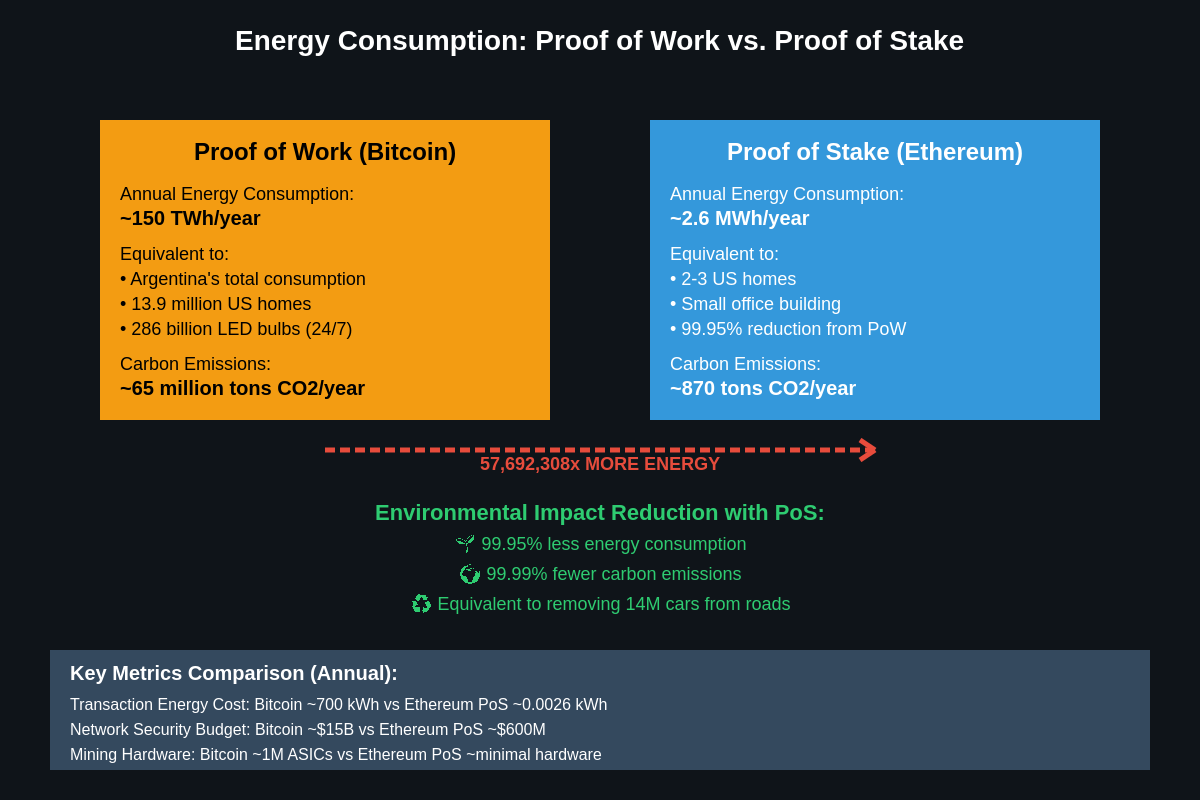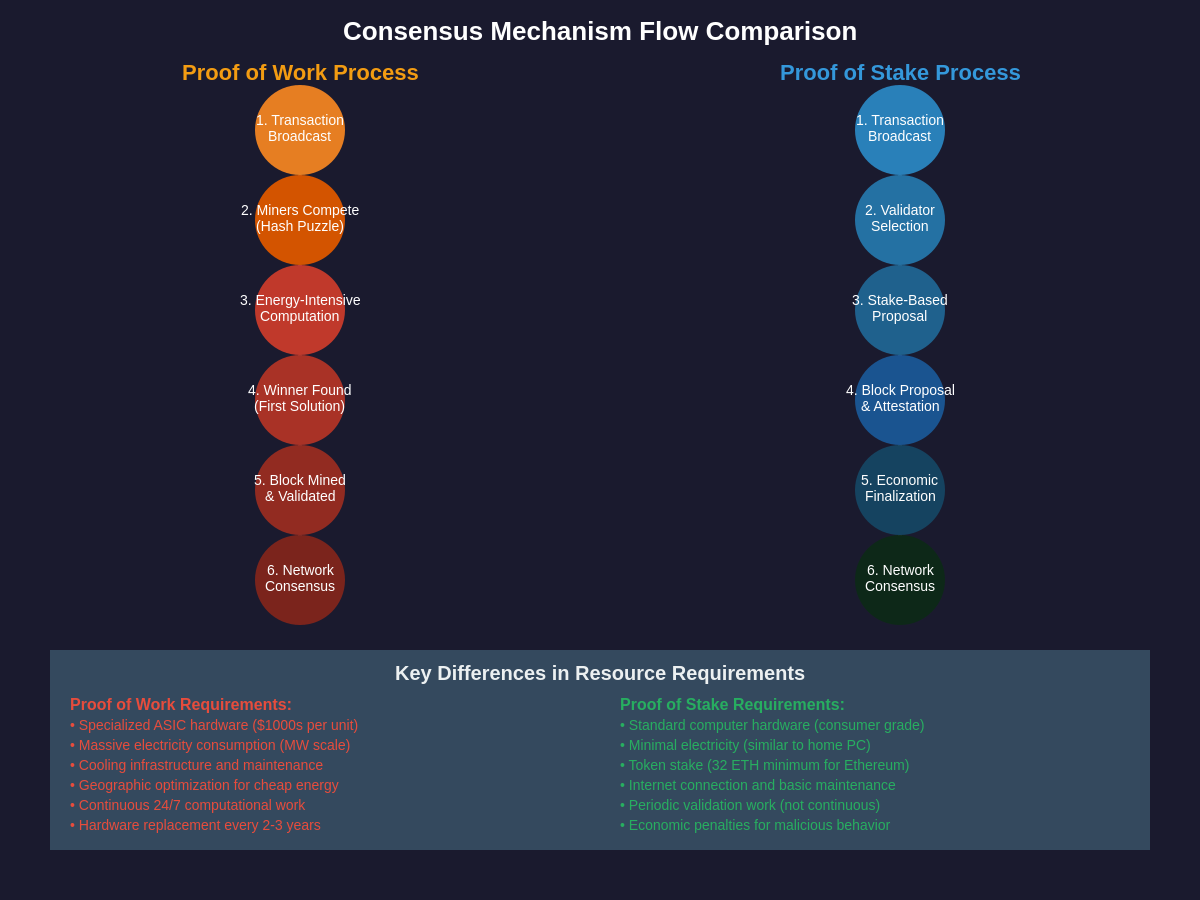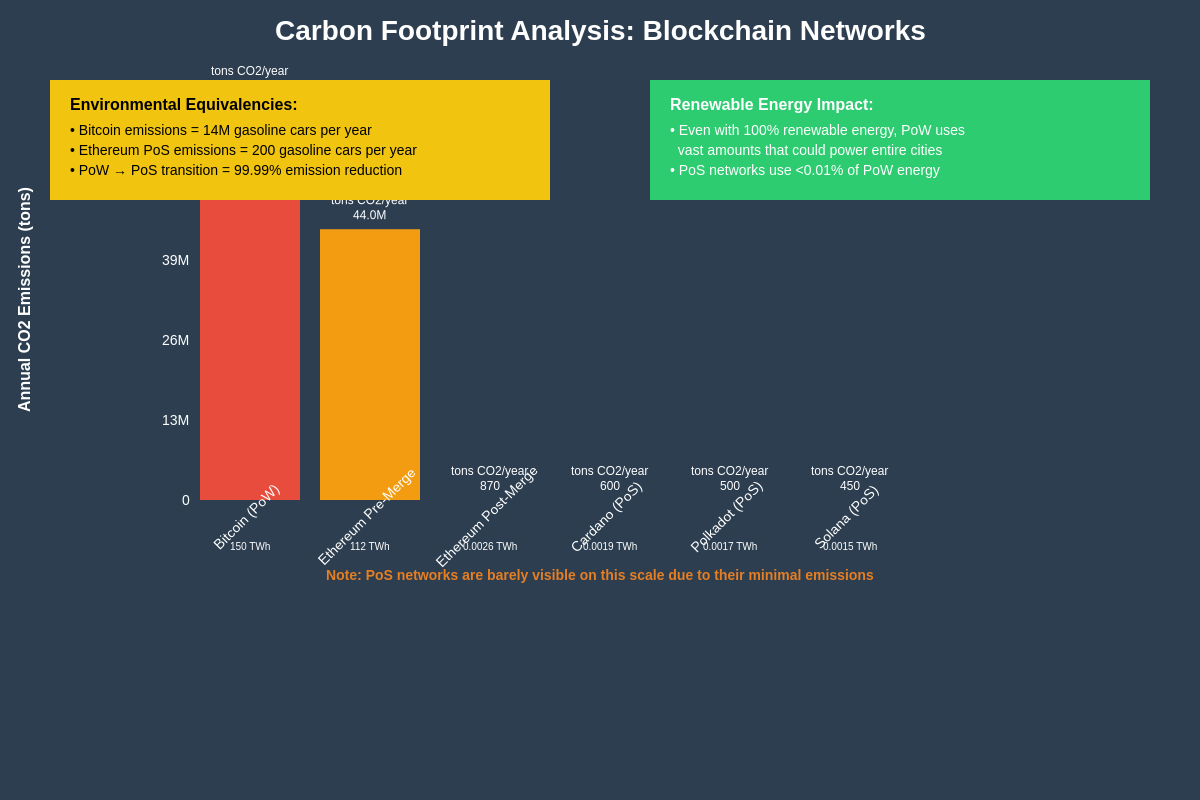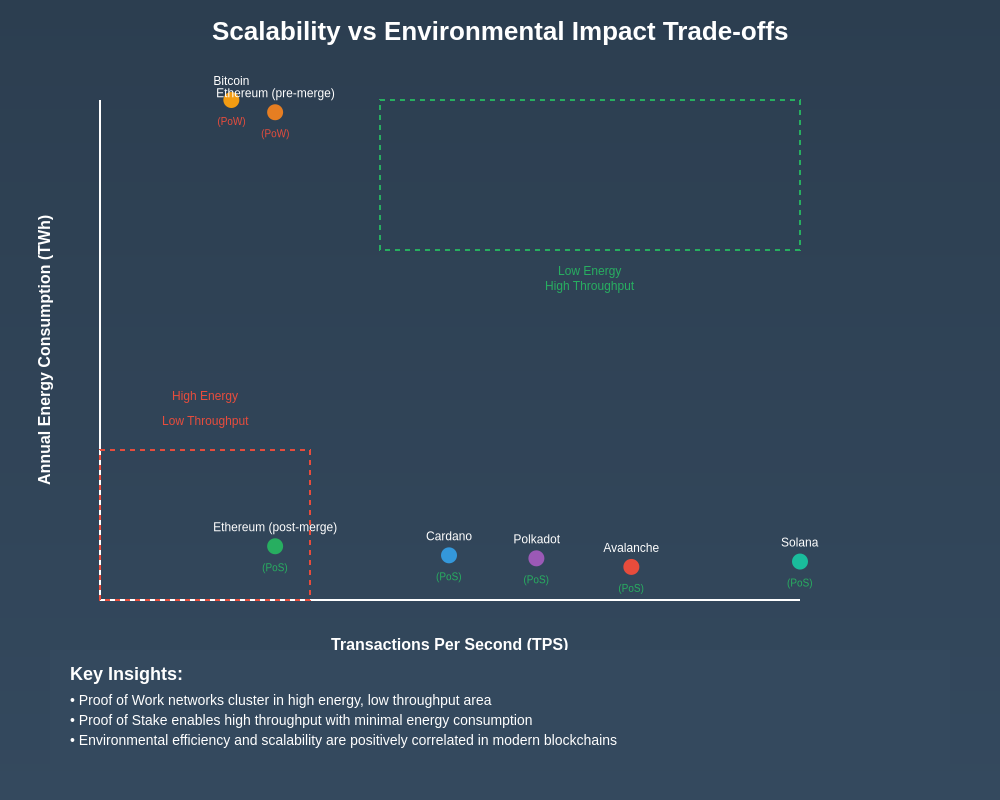Visit TradingView for comprehensive cryptocurrency analysis and environmental impact data
The Great Sustainability Divide in Blockchain Technology
The environmental impact of blockchain technology has emerged as one of the most contentious debates in the cryptocurrency ecosystem, fundamentally dividing the community between those who champion the proven security of energy-intensive proof-of-work systems and advocates for the environmental sustainability promised by proof-of-stake alternatives. This ongoing discussion has profound implications not only for the technical architecture of blockchain networks but also for their long-term viability in an increasingly climate-conscious world where regulatory pressure and public scrutiny continue to intensify around carbon footprints and energy consumption patterns.

The complexity of this debate extends far beyond simple energy consumption metrics, encompassing questions of network security, decentralization principles, economic incentives, and the fundamental trade-offs inherent in distributed consensus mechanisms. While critics point to alarming statistics about Bitcoin’s annual energy consumption rivaling that of entire countries, proponents argue that this energy expenditure serves a critical purpose in securing a truly decentralized monetary system that operates independently of traditional financial institutions and government control.
Understanding Proof of Work: The Original Consensus Mechanism
Proof of work represents the foundational consensus mechanism that enabled Bitcoin to solve the double-spending problem without requiring trusted third parties, establishing a revolutionary approach to digital scarcity that relies on computational work to validate transactions and secure the network. This mechanism requires miners to compete in solving cryptographically difficult puzzles that demand significant computational resources, with the successful miner earning the right to add the next block to the blockchain and receive associated rewards in cryptocurrency.
The elegance of proof of work lies in its simplicity and the direct relationship between energy expenditure and network security, creating a system where attacking the network becomes increasingly expensive as more miners participate and the overall hash rate increases. This security model has proven remarkably resilient over Bitcoin’s fifteen-year operational history, withstanding numerous attempted attacks and maintaining consistent operation even during periods of extreme market volatility and regulatory uncertainty.
However, the environmental implications of this security model have become increasingly problematic as the network has scaled and cryptocurrency prices tracked on TradingView have incentivized massive investments in mining infrastructure. The competitive nature of mining has led to an arms race in computational power, with miners deploying increasingly powerful and energy-hungry hardware to maintain profitability in an environment where only the most efficient operations can survive.
The geographic distribution of mining operations has also created complex environmental considerations, with mining activity gravitating toward regions with cheap electricity, often regardless of whether that power comes from renewable or fossil fuel sources. This dynamic has led to situations where entire regions have experienced increased carbon emissions due to cryptocurrency mining, particularly in areas where coal-fired power plants provide the cheapest available electricity.
The Promise of Proof of Stake: A Sustainable Alternative
Proof of stake emerged as a proposed solution to the environmental concerns associated with proof of work, fundamentally reimagining the consensus mechanism by replacing energy-intensive computational competition with an economic staking model where validators are selected to propose blocks based on their ownership stake in the network rather than their computational power. This approach dramatically reduces energy consumption by eliminating the need for continuous competitive mining while maintaining security through economic incentives that make attacking the network economically irrational.

The theoretical advantages of proof of stake extend beyond environmental considerations to include improved scalability, reduced barriers to participation, and enhanced governance mechanisms that allow stakeholders to have direct input into network upgrades and policy decisions. Unlike proof of work, where mining requires specialized hardware and technical expertise, proof of stake allows any token holder to participate in network consensus by delegating their stake to validators, democratizing participation in network security.
Ethereum’s transition from proof of work to proof of stake through “The Merge” in September 2022 represented the most significant real-world test of this consensus mechanism at scale, providing valuable data about the practical implications of such a transition for a major blockchain network. The successful completion of this transition demonstrated that proof of stake could maintain network security while reducing energy consumption by approximately 99.95%, offering concrete evidence that sustainable blockchain technology is not merely theoretical but practically achievable.
The economic model underlying proof of stake creates different incentive structures compared to proof of work, with validators earning rewards for honest participation while facing the risk of having their staked tokens “slashed” or permanently destroyed for malicious behavior. This model aligns validators’ interests with the long-term health of the network, as their financial stake in the system creates strong incentives to maintain network integrity and follow protocol rules.
Environmental Impact Analysis: Quantifying the Difference
The environmental impact differential between proof of work and proof of stake systems is staggering in its magnitude, with research indicating that Bitcoin’s annual energy consumption approaches 150 terawatt-hours, roughly equivalent to the total electricity consumption of Argentina, while comparable proof-of-stake networks consume less energy than a typical data center. These figures represent more than just abstract statistics; they translate into tangible carbon emissions that contribute to global climate change and raise serious questions about the sustainability of energy-intensive consensus mechanisms.

Detailed analysis of Bitcoin’s energy consumption patterns tracked through various monitoring platforms reveals significant variations based on factors including network hash rate, mining hardware efficiency, electricity costs, and the geographic distribution of mining operations. The Cambridge Bitcoin Electricity Consumption Index provides ongoing monitoring of these metrics, showing how Bitcoin’s energy usage fluctuates with market conditions and technological improvements in mining hardware.
The carbon intensity of cryptocurrency mining varies dramatically depending on the energy sources used by mining operations, with some studies suggesting that renewable energy accounts for a significant portion of mining energy consumption while others point to continued reliance on fossil fuels in many mining regions. This variability makes it challenging to provide definitive carbon footprint calculations, but most estimates place Bitcoin’s annual carbon emissions between 50 and 70 million tons of CO2 equivalent.
In contrast, proof-of-stake networks like Ethereum post-Merge consume approximately 2.6 megawatt-hours annually, representing a reduction of several orders of magnitude compared to proof-of-work systems. This dramatic efficiency improvement demonstrates the potential for blockchain technology to operate at global scale without contributing significantly to energy consumption or carbon emissions, making it more compatible with climate change mitigation efforts.
The broader implications of these energy consumption patterns extend beyond direct environmental impact to include opportunity costs associated with using renewable energy resources for cryptocurrency mining rather than displacing fossil fuel consumption in other sectors. Economic analysis suggests that the energy consumed by proof-of-work mining could power millions of homes or support industrial processes that provide broader social and economic benefits.
Security Considerations and Trade-offs
The fundamental security properties of proof-of-work and proof-of-stake systems differ in ways that have significant implications for their respective environmental justifications, with proof-of-work proponents arguing that the energy expenditure serves as an essential component of the security model that cannot be replicated through economic staking alone. The concept of “unforgeable costliness” suggests that the energy invested in proof-of-work mining creates an objective anchor for consensus that is impossible to fake or manipulate, providing a level of security assurance that may justify the environmental costs.
Critics of this argument contend that proof-of-stake systems can achieve equivalent or superior security through different mechanisms, pointing to the successful operation of networks like Ethereum, Cardano, and Polkadot as evidence that economic incentives can provide robust security without energy-intensive mining. The slashing mechanism in proof-of-stake systems creates immediate financial consequences for malicious behavior, potentially providing stronger deterrents than the sunk costs associated with proof-of-work mining.
The “nothing at stake” problem, frequently cited as a fundamental weakness of proof-of-stake systems, suggests that validators have no inherent cost to validating multiple competing chains simultaneously, potentially leading to consensus instability. However, modern proof-of-stake implementations have developed sophisticated solutions to this problem, including slashing conditions that penalize validators for contradictory behavior and finality mechanisms that prevent certain types of chain reorganizations.
Long-term security considerations also differ between the two consensus mechanisms, with proof-of-work potentially becoming more vulnerable as block rewards decrease and transaction fees must support network security, while proof-of-stake systems may face concentration risks as large stakeholders accumulate increasing influence over network governance. These evolving security dynamics have important implications for the environmental debate, as they affect the justification for energy expenditure in proof-of-work systems.
The resilience of proof-of-work systems to various attack vectors, including quantum computing threats, regulatory pressure, and coordinated nation-state attacks, represents another dimension of the security debate that intersects with environmental considerations. Some analysts argue that the decentralized and geographically distributed nature of proof-of-work mining provides unique resistance to censorship and control that may be worth the environmental costs in certain geopolitical contexts.
Economic Incentives and Market Dynamics
The economic structures underlying proof-of-work and proof-of-stake systems create vastly different relationships with energy consumption and environmental impact, influencing not only the direct carbon footprint of these networks but also their long-term sustainability and ability to adapt to changing environmental regulations and social expectations. Proof-of-work mining economics are fundamentally tied to energy costs, creating direct financial incentives for miners to seek the cheapest available electricity sources, which often means gravitating toward regions with abundant fossil fuel resources or stranded renewable energy capacity.
This economic dynamic has led to interesting developments in renewable energy adoption, with some mining operations partnering with solar and wind projects to utilize excess capacity that would otherwise be curtailed, potentially improving the economics of renewable energy infrastructure development. However, critics argue that this narrative oversimplifies the complex relationship between mining and renewable energy, noting that mining operations often require consistent baseload power that is more easily provided by fossil fuel sources than by intermittent renewable generation.
The profitability cycles inherent in proof-of-work mining create additional environmental complexities, as periods of high cryptocurrency prices incentivize expanded mining capacity and increased energy consumption, while market downturns can lead to mining operations shutting down and potentially reducing environmental impact. This cyclical relationship between market conditions and environmental impact makes it challenging to predict the long-term environmental trajectory of proof-of-work networks.
Proof-of-stake economics operate on fundamentally different principles, with validator rewards based on staked token holdings rather than energy expenditure, decoupling network security from environmental impact while creating different types of economic incentives and potential concentrations of power. The staking rewards structure in proof-of-stake systems can influence token distribution patterns and network governance dynamics, with implications for both decentralization and environmental sustainability.
The emergence of liquid staking protocols and staking-as-a-service providers has further complicated the economic landscape of proof-of-stake systems, potentially creating new forms of centralization risk while making participation more accessible to smaller stakeholders. These developments have important implications for the environmental debate, as they affect the overall sustainability and democratic nature of proof-of-stake networks.
Regulatory Response and Policy Implications
Government and regulatory responses to the environmental impact of cryptocurrencies have varied dramatically across jurisdictions, reflecting different priorities, energy policies, and approaches to emerging technology regulation, while increasingly influencing the competitive dynamics between proof-of-work and proof-of-stake systems. The European Union has been among the most aggressive in addressing cryptocurrency environmental concerns, with proposals ranging from outright bans on proof-of-work mining to carbon taxation schemes that would make energy-intensive consensus mechanisms economically unviable.
China’s complete ban on cryptocurrency mining in 2021 represented the most dramatic regulatory response to environmental concerns, effectively eliminating a significant portion of global Bitcoin mining capacity overnight and forcing mining operations to relocate to other jurisdictions with different environmental and regulatory profiles. This policy shift had immediate environmental implications, as mining operations moved to regions with different energy mix profiles, potentially altering the overall carbon intensity of Bitcoin mining.
The United States has taken a more nuanced approach, with different states adopting varying policies toward cryptocurrency mining based on their energy resources, environmental priorities, and economic development strategies. States with abundant renewable energy resources have generally been more welcoming to mining operations, while regions facing energy capacity constraints or environmental justice concerns have implemented restrictions or moratoriums on new mining facilities.
Regulatory pressure has also manifested through environmental reporting requirements, with some jurisdictions mandating that cryptocurrency companies disclose their energy consumption and carbon emissions as part of broader climate disclosure frameworks. These requirements are creating additional compliance costs for proof-of-work networks while potentially advantaging proof-of-stake alternatives that can more easily demonstrate environmental sustainability.
The development of carbon credit markets and offset mechanisms for cryptocurrency operations represents another regulatory trend that could significantly impact the relative economics of different consensus mechanisms. Some mining operations have begun purchasing carbon offsets to neutralize their environmental impact, though the effectiveness and integrity of such offset programs remain subjects of ongoing debate within both cryptocurrency and environmental communities.
Technological Innovations and Hybrid Solutions
The stark dichotomy between proof-of-work and proof-of-stake has given rise to numerous technological innovations and hybrid approaches that attempt to capture the benefits of both consensus mechanisms while minimizing their respective drawbacks, particularly regarding environmental impact and security trade-offs. These emerging solutions represent the cutting edge of blockchain consensus research and may ultimately provide pathways to more sustainable and secure distributed systems.
Delegated proof-of-stake represents one such hybrid approach that combines elements of both consensus mechanisms by allowing token holders to vote for a limited number of delegates who are responsible for block production, potentially providing improved energy efficiency compared to proof-of-work while maintaining stronger decentralization properties than traditional proof-of-stake systems. This model has been implemented by several major blockchain networks and offers interesting insights into alternative governance and consensus structures.
Proof-of-authority systems represent another hybrid approach that prioritizes energy efficiency by relying on pre-approved validators rather than competitive mining or token-based staking, though these systems typically sacrifice decentralization for improved environmental performance and transaction throughput. While such systems may not be suitable for public, permissionless networks, they offer valuable lessons about the environmental possibilities of blockchain technology in enterprise and consortium contexts.
The development of sharding and layer-2 scaling solutions has also contributed to the environmental debate by potentially reducing the energy intensity of transactions even within proof-of-work systems, though these solutions introduce additional complexity and potential security trade-offs that must be carefully evaluated. Layer-2 solutions like the Lightning Network for Bitcoin and various Ethereum scaling solutions can process large numbers of transactions while requiring minimal additional energy consumption from the underlying blockchain.
More exotic consensus mechanisms continue to emerge from academic research, including proof-of-space-time, proof-of-history, and various forms of byzantine fault tolerance that attempt to optimize different aspects of the security-efficiency-decentralization trilemma. While many of these mechanisms remain theoretical or implemented only in experimental contexts, they represent ongoing innovation in addressing the environmental challenges of blockchain consensus.
Industry Response and Corporate Adoption
The corporate response to environmental concerns about blockchain technology has been varied and evolving, with many companies adopting explicit sustainability policies that favor proof-of-stake networks while others continue to support proof-of-work systems through various justifications and offset strategies. Major technology companies like Microsoft, Google, and Amazon have generally avoided supporting proof-of-work mining operations while embracing proof-of-stake networks for their blockchain initiatives and partnerships.
Financial institutions have shown particular sensitivity to environmental concerns when developing cryptocurrency strategies, with many major banks and investment firms citing environmental impact as a factor in their decisions about which digital assets to support or offer to clients. The Environmental, Social, and Governance (ESG) investment framework has become increasingly important in institutional cryptocurrency adoption, generally favoring more environmentally sustainable blockchain networks.
Tesla’s highly publicized decision to accept and then discontinue Bitcoin payments due to environmental concerns highlighted the potential business impact of the consensus mechanism debate, while the company’s continued holdings of Bitcoin and support for more sustainable cryptocurrencies illustrates the complex considerations facing corporations navigating this landscape. The market reaction to Tesla’s announcements demonstrated the significant influence that corporate environmental policies can have on cryptocurrency valuations and market sentiment.
The emergence of green cryptocurrency funds and sustainable blockchain investment products reflects growing institutional demand for environmentally conscious digital asset exposure, with many such products explicitly excluding proof-of-work cryptocurrencies or applying additional screening criteria based on energy consumption and carbon intensity metrics. This trend suggests that environmental considerations are becoming increasingly important factors in institutional cryptocurrency adoption and may drive further innovation in sustainable consensus mechanisms.
Corporate mining operations have also begun implementing various sustainability initiatives, including commitments to renewable energy sourcing, carbon neutrality goals, and participation in industry sustainability councils and reporting frameworks. While these efforts may help address some environmental concerns about proof-of-work mining, they also highlight the ongoing challenges of operating energy-intensive consensus mechanisms in an increasingly climate-conscious business environment.
Technical Performance and Scalability Implications
The performance characteristics of proof-of-work and proof-of-stake systems extend beyond energy consumption to include transaction throughput, confirmation times, and scalability limitations that have important implications for their environmental efficiency per transaction and overall sustainability as global payment and computing platforms. Bitcoin’s proof-of-work system processes approximately seven transactions per second with confirmation times measured in minutes or hours, while modern proof-of-stake systems can handle thousands of transactions per second with sub-second finality.

These performance differences have significant implications for environmental impact calculations, as the energy consumption per transaction varies dramatically between the two consensus mechanisms even before considering the absolute energy consumption differences. When Bitcoin’s total energy consumption is divided by its transaction throughput, the environmental cost per transaction appears extremely high compared to proof-of-stake alternatives, though proponents argue that this comparison is misleading because it ignores the different security and finality properties of the two systems.
The development of layer-2 scaling solutions for proof-of-work networks has somewhat complicated these comparisons, as technologies like the Lightning Network can process large numbers of transactions while requiring minimal additional energy from the base layer blockchain. However, the security and decentralization properties of layer-2 solutions depend on the underlying blockchain, meaning that the environmental impact of the base layer remains relevant even when most transactions occur on higher layers.
Proof-of-stake networks have generally demonstrated superior scalability characteristics, with many systems capable of processing thousands of transactions per second while maintaining energy consumption levels that are orders of magnitude lower than proof-of-work systems. This scalability advantage has important implications for the environmental sustainability of blockchain technology as it scales to serve larger user bases and handle more complex applications.
The emergence of specialized blockchain networks optimized for specific use cases has also influenced the environmental debate, with some proof-of-work networks focusing on digital gold-like store of value properties while proof-of-stake networks often emphasize smart contract functionality and decentralized application support. These different focus areas may justify different environmental trade-offs, though the overall trend toward multi-purpose blockchain platforms has generally favored more energy-efficient consensus mechanisms.
Global Energy Grid Integration and Infrastructure
The integration of cryptocurrency mining operations with global energy infrastructure has created complex interactions between blockchain networks and electrical grids that extend the environmental debate beyond simple carbon accounting to include questions about energy system stability, renewable energy development, and grid modernization efforts. Large-scale mining operations can represent significant electricity demand that affects local and regional energy markets, potentially influencing electricity prices, grid stability, and investment in generation capacity.
Some jurisdictions have experienced strain on their electrical infrastructure due to rapid growth in cryptocurrency mining, leading to concerns about grid reliability and potential impacts on other electricity consumers, while other regions have embraced mining operations as a source of stable electricity demand that can support renewable energy development and grid modernization investments. The relationship between mining and renewable energy development remains contentious, with different studies reaching conflicting conclusions about whether mining operations support or hinder clean energy deployment.
The concept of mining operations serving as controllable loads that can be curtailed during periods of high electricity demand has gained attention as a potential grid services application, with some mining operations partnering with grid operators to provide demand response services that help stabilize electrical systems. This model could potentially improve the environmental profile of proof-of-work mining while providing valuable grid services, though the practical implementation of such arrangements remains limited.
Energy storage integration represents another area where mining operations might contribute to grid modernization and renewable energy adoption, with some projects exploring the use of battery storage systems to power mining operations during peak renewable generation periods while providing grid services during other times. These hybrid energy-mining projects represent innovative approaches to addressing the environmental concerns of proof-of-work mining while supporting clean energy infrastructure development.
The geographic distribution of mining operations continues to evolve in response to energy costs, regulatory policies, and access to renewable energy resources, creating dynamic patterns of electricity consumption that affect regional energy markets and environmental impacts. Understanding these patterns is crucial for accurately assessing the environmental implications of different consensus mechanisms and developing policies that support sustainable blockchain development.
Future Outlook and Emerging Trends
The future trajectory of the environmental debate between proof-of-work and proof-of-stake systems will likely be influenced by a complex interplay of technological innovation, regulatory pressure, market dynamics, and evolving social attitudes toward environmental sustainability, with several key trends already beginning to shape the landscape. The continued improvement in renewable energy economics and deployment may reduce the carbon intensity of proof-of-work mining, while advances in proof-of-stake technology and implementation may further improve the efficiency and security of alternative consensus mechanisms.
The potential development of quantum computing technology represents a long-term threat to all current cryptographic systems, including both proof-of-work and proof-of-stake blockchains, though the timeline and implications of quantum computing breakthroughs remain highly uncertain. The response to quantum threats may require fundamental changes to blockchain security models that could significantly alter the environmental implications of different consensus mechanisms.
Central bank digital currencies (CBDCs) and government-issued digital assets generally favor energy-efficient consensus mechanisms, potentially reducing the market demand for energy-intensive blockchain networks while increasing the adoption of more sustainable alternatives. The widespread deployment of CBDCs could significantly influence the environmental profile of the global digital payments system, though the centralized nature of most CBDC designs raises different questions about decentralization and financial sovereignty.
The integration of artificial intelligence and machine learning technologies with blockchain systems may create new applications and use cases that favor different consensus mechanisms based on their computational requirements and energy constraints, while the continued growth of decentralized finance (DeFi) applications generally favors more efficient and scalable blockchain platforms that can support complex smart contract interactions.
Climate change mitigation efforts and carbon pricing mechanisms are likely to become increasingly important factors in the economic viability of different consensus mechanisms, with proof-of-work systems potentially facing higher costs due to carbon taxes or emissions trading systems while proof-of-stake alternatives may benefit from environmental subsidies or preferential treatment in green investment frameworks.
Disclaimer: This article is for informational purposes only and does not constitute financial advice. Cryptocurrency investments carry significant risks, and readers should conduct their own research and consult with qualified financial advisors before making investment decisions. The environmental impact of blockchain technologies continues to evolve, and readers should stay informed about the latest developments in consensus mechanisms and sustainability initiatives.